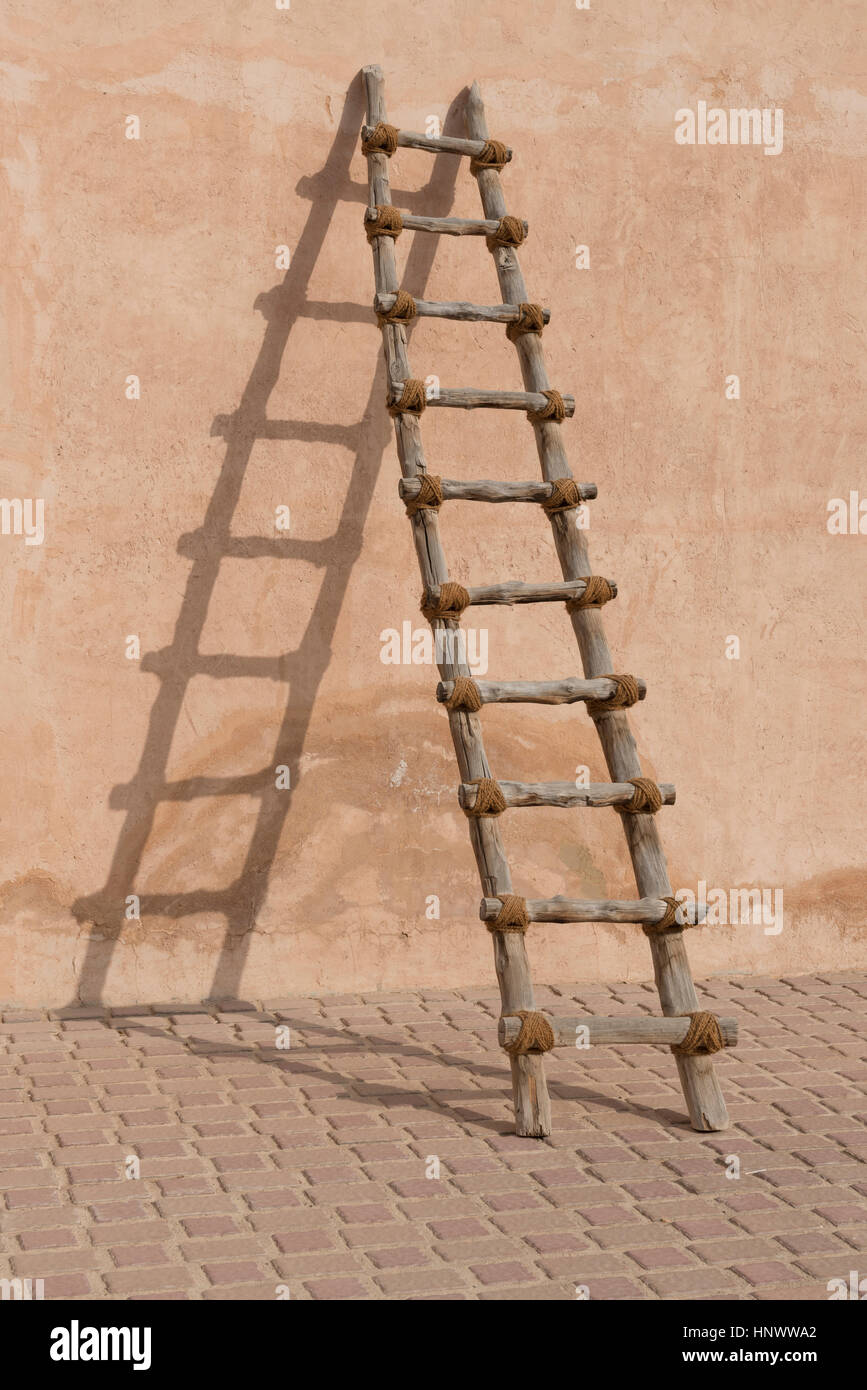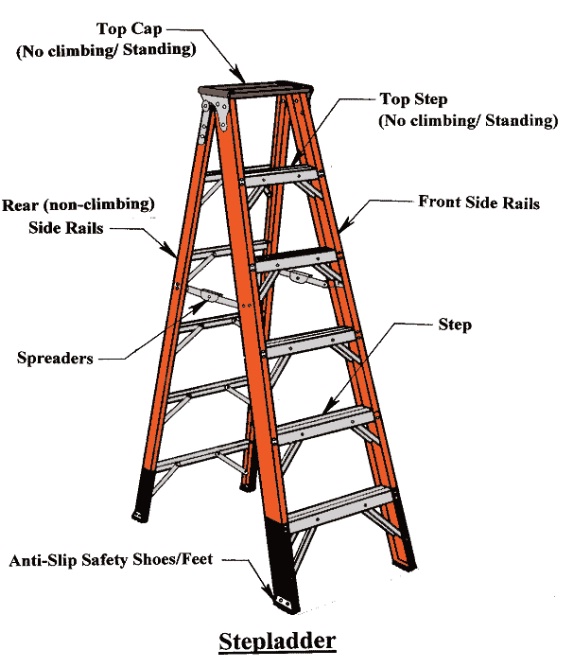Ladders are essential tools in many tasks. They come in different materials to suit various needs.
Understanding what ladders are made out of helps in choosing the right one for your task. Ladders can be made from several materials, each offering unique benefits. Common materials include wood, aluminum, fiberglass, and steel. Each type has its advantages, whether it’s the lightweight nature of aluminum or the sturdiness of steel.
Knowing the differences can ensure safety and efficiency in your work. We’ll explore the materials used in ladders and help you decide which is best for you. Whether for home or professional use, understanding ladder materials is key. Stay with us to learn more about the options available.

Credit: www.alamy.com
Wooden Ladders
Wooden ladders have been around for centuries. They are popular for their traditional look and sturdy feel. Many people prefer wooden ladders for their durability and natural appeal. Let’s explore the types of wood used, as well as their advantages and disadvantages.
Types Of Wood Used
Different types of wood are used to make wooden ladders. Each type of wood has its own characteristics. Here are some common types:
- Pine: Pine is lightweight and affordable. It is easy to find and work with.
- Oak: Oak is strong and durable. It can handle heavy weights.
- Maple: Maple is known for its hardness. It is resistant to wear and tear.
Advantages And Disadvantages
Wooden ladders come with a set of advantages and disadvantages. Understanding these can help you make an informed decision.
| Advantages | Disadvantages |
|---|---|
| Wooden ladders are sturdy and reliable. | They can be heavy and difficult to move. |
| They offer a natural look that many people prefer. | Wood can rot or warp if not properly cared for. |
| Wood is a renewable resource. | Wooden ladders can be expensive compared to other materials. |
Aluminum Ladders
Aluminum ladders are a popular choice for many due to their durability and lightweight nature. They are versatile and can be used in various settings, from homes to construction sites.
Benefits Of Aluminum
Aluminum ladders offer several advantages:
- Lightweight: Easy to carry and transport.
- Durable: Resistant to corrosion and rust.
- Strong: Can support heavy weights despite their lightness.
- Non-conductive: Safe for electrical work when treated.
- Low Maintenance: Requires minimal upkeep compared to other materials.
Common Uses
Aluminum ladders are used in many different scenarios:
- Home Improvement: Ideal for painting, cleaning gutters, and accessing high shelves.
- Construction Sites: Commonly used due to their strength and durability.
- Electrical Work: Non-conductive properties make them safe for electricians.
- Gardening: Useful for trimming trees and hedges.
- Warehouse Work: Perfect for reaching high storage areas.
Aluminum ladders come in various types, such as step ladders, extension ladders, and multi-position ladders. Their versatility makes them a go-to choice for many tasks.
Fiberglass Ladders
Fiberglass ladders are a popular choice for both professionals and homeowners. They are known for their strength, safety, and durability. These ladders are made from a material called fiberglass, which is a type of reinforced plastic. This gives them unique advantages over other types of ladders.
Strength And Durability
Fiberglass ladders are extremely strong and durable. They are capable of supporting heavy loads without bending or breaking. This makes them ideal for various tasks, including construction and home improvement.
Unlike wood ladders, fiberglass does not absorb moisture. This means that fiberglass ladders will not rot or warp over time. They are also resistant to weather conditions, making them suitable for both indoor and outdoor use.
Another benefit is their resistance to chemicals. Fiberglass ladders can withstand exposure to many types of chemicals without damage. This quality makes them perfect for industrial environments where such exposure is common.
Safety Features
Safety is a key feature of fiberglass ladders. One of the most important safety aspects is their non-conductive nature. Unlike metal ladders, fiberglass does not conduct electricity. This makes fiberglass ladders safe for use around electrical wiring and equipment.
Fiberglass ladders also have non-slip surfaces on their steps and rungs. This reduces the risk of slipping and falling while climbing. Many fiberglass ladders come with additional safety features such as rubber feet. These feet provide extra grip and stability on various surfaces.
Some models include additional safety features like stabilizer bars and locking mechanisms. These features ensure that the ladder remains stable and secure during use. This minimizes the risk of accidents and injuries.
| Feature | Description |
|---|---|
| Strength | Supports heavy loads without bending |
| Durability | Resistant to moisture, weather, and chemicals |
| Non-conductive | Safe for electrical work |
| Non-slip surfaces | Reduces the risk of slipping |
| Extra safety features | Stabilizer bars, locking mechanisms, rubber feet |

Credit: www.pinterest.com
Steel Ladders
Steel ladders are known for their durability and strength. These ladders are a popular choice for various applications, especially in industrial settings. Let’s explore the benefits of steel ladders under two main headings: Strength and Weight and Industrial Applications.
Strength And Weight
Steel ladders are incredibly strong. They can support heavy weights without bending. This makes them ideal for heavy-duty tasks. Their strength comes from the material itself. Steel is known for its high tensile strength. This means it can withstand a lot of force before breaking.
Despite their strength, steel ladders are not the lightest option. They are heavier than aluminum or fiberglass ladders. This can make them harder to move around. But, this extra weight adds to their stability. When you need a ladder that won’t wobble, steel is a good choice.
| Material | Strength | Weight |
|---|---|---|
| Steel | High | Heavy |
| Aluminum | Medium | Light |
| Fiberglass | High | Medium |
Industrial Applications
Steel ladders are often used in industrial environments. They are perfect for construction sites. Their strength allows them to carry heavy tools and materials. They are also resistant to impacts and harsh conditions.
Many warehouses use steel ladders. They help workers reach high shelves safely. Their stability is crucial in these settings. Factories also rely on steel ladders. They are used for maintenance and repairs. These ladders can handle the tough conditions found in such places.
- Construction sites
- Warehouses
- Factories
In summary, steel ladders are essential in many industrial applications. Their strength and durability make them a reliable tool in demanding environments.
Plastic Ladders
Plastic ladders are a popular choice for homeowners and professionals. They are lightweight, durable, and resistant to many chemicals. These ladders are non-conductive, making them safe for electrical work. Let’s explore when to use plastic ladders and their limitations.
When To Use Plastic
Plastic ladders are ideal for indoor use. They are great for tasks like painting, reaching high shelves, and changing light bulbs. Since they are non-conductive, they are perfect for electricians and anyone working near electrical wires. Their lightweight nature makes them easy to carry around the house or workplace.
Plastic ladders are also suitable for wet environments. They resist rust and corrosion, making them excellent for use in bathrooms, kitchens, and outdoors. Their resistance to chemicals ensures they remain in good condition even when exposed to cleaning agents.
Limitations
Despite their many advantages, plastic ladders have some limitations. They are not as strong as metal ladders, which means they cannot support very heavy loads. Most plastic ladders have a weight limit of around 200 to 250 pounds. They are not suitable for heavy-duty tasks.
Plastic ladders can also become brittle in extremely cold temperatures. This brittleness can lead to cracking or breaking. Therefore, they are not ideal for outdoor use in very cold weather. Additionally, they can degrade under prolonged exposure to UV light. This degradation can weaken the ladder over time.
Here is a quick comparison of the features of plastic ladders:
| Feature | Plastic Ladders |
|---|---|
| Weight | Lightweight |
| Conductivity | Non-conductive |
| Resistance | Resistant to chemicals and rust |
| Strength | Less strong than metal |
| Cold Weather | Can become brittle |
| UV Exposure | Can degrade over time |
Consider these factors when choosing a plastic ladder for your needs.

Credit: www.americanladderinstitute.org
Composite Ladders
Composite ladders are a type of ladder made from a combination of materials. These ladders are known for their strength and durability. They are ideal for various uses around the home and workplace. Let’s dive into the specifics of composite ladders.
Material Composition
Composite ladders are made from a mix of materials. The main materials include fiberglass and reinforced plastics. This combination offers excellent strength and stability. The fiberglass provides insulation, making these ladders safe for electrical work.
Here is a table showing the common materials used in composite ladders:
| Material | Properties |
|---|---|
| Fiberglass | Insulating, strong, lightweight |
| Reinforced Plastics | Durable, resistant to corrosion |
These materials make composite ladders both durable and lightweight. This makes them easy to carry and use.
Ideal Uses
Composite ladders are versatile and can be used in many situations. Here are some ideal uses:
- Electrical Work: Fiberglass insulation keeps you safe.
- Outdoor Tasks: Resistant to weather and corrosion.
- Home Projects: Lightweight and easy to move around.
These ladders are perfect for tasks where safety and durability are crucial. You can trust them for both professional and home use.
Frequently Asked Questions
What Materials Are Ladders Made From?
Ladders are typically made from aluminum, fiberglass, or wood. Each material has its own benefits.
Are Aluminum Ladders Safe?
Yes, aluminum ladders are safe. They are lightweight, sturdy, and resistant to rust.
Why Use Fiberglass Ladders?
Fiberglass ladders are non-conductive. This makes them ideal for electrical work. They are also durable and strong.
How Long Do Wooden Ladders Last?
Wooden ladders can last many years. Proper care and storage are essential. They are strong but can rot if wet.
Which Ladder Material Is Best For Outdoor Use?
Aluminum and fiberglass are best for outdoor use. They resist weather damage better than wood.
Conclusion
Ladders come in various materials, each with unique benefits. Wood offers strength and stability. Aluminum is lightweight and resistant to rust. Fiberglass provides safety against electrical hazards. Choosing the right ladder material depends on your needs. Always consider the task and environment.
Safety first. Select wisely for a reliable, long-lasting tool. A good ladder can make tasks easier and safer.
Recent Posts
Maintaining clean gutters is essential for preventing water damage to your home, and choosing the best ladder for cleaning gutters can make the job much easier and safer. With so many options on the...
Best Ladder for Cleaning Caravan Roof: Top Picks for You Every Adventure!
Today we will discuss the best ladder for cleaning caravan roof. Cleaning caravan roofs is one of the crucial tasks.After many days, a caravan roof can get dirty by debris, dirt, and grime. These can...
